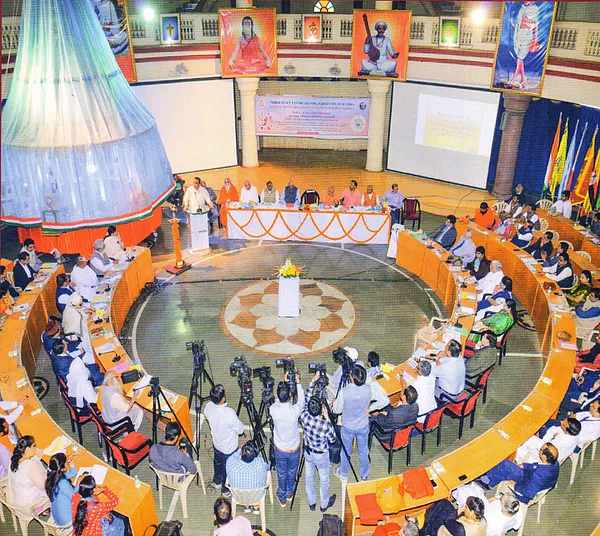
WORLD PEACE CENTER WORK
Helping the disaster afflicted in Nepal
The 2015 earthquake that rocked Nepal was one of the worst disasters to befall the Mountain nation ever. More than 8000 people died and more than thrice that number were injured. Hundreds of thousands were rendered homeless and entire districts were cut off from Kathmandu for months.
The World Peace Center (Alandi), could not remain impassive in this time of need of the Nepali people. Notwithstanding the enormous technical hassles presented, MAEER’s MIT decided to aid the affected people in any way they could.
There was relief material sent along with volunteers to oversee a fair and efficient distribution. This team consisted of ex-students, students and faculty. Next, an earthquake resistant house was built as a prototype within the MIT, Pune campus.

Then, on the peaceful occasion of Buddha Jayanti, 120 such houses were built by MIT in Nepal and presented to the families who had lost their homes in the calamity. Not only that, but the damaged ‘Purano Gujeshwari’ temple was also rebuilt by MIT as a gesture of peace, harmony and solidarity for the people of Nepal. The presentation of the houses was done under the auspices of Spiritual Guru Sri M and Prof Dr Vishwanath D Karad.
The Road to peace starts at Rui, Latur (India)
The village of Rui located within the Latur district of Maharashtra is a veritable microcosm of the nation of India itself. The villagers of Rui are predominantly Hindus with sizeable Muslim and Buddhist minorities, and they all have been happily coexisting for a very long time. This is the hometown of MAEER’S founder and the iconic educationist, Prof Dr Vishwanath D Karad and perhaps that is where he got his inspiration for the virtues and values of ‘Vasudhaiva Kutumbakam’. Shri Karad’s World Peace ideology must have seen its inception within the peaceful environs of Rui and his firm desire to see the world live in peace and harmony must also have been influenced by what he felt and experienced growing up there.
That is not to say that the village has not seen its share of communal discord. Roughly 275 years ago the marauding armies of the Nizam saw fit to destroy the ancient Sriram temple located within the village and as recently as the 1940’s, during the Razakar agitation, Hindu mobs destroyed the Jumma Masjid and Khwaja Zainuddin Dargah situated within the village limits. Time and the locals themselves, proved to be the ablest healers in this communal discord. And in 2011, a miracle happened….
Hindus and Muslims came together in the year 2011 to rebuilt the destroyed mosque and temple, and through that act, celebrate diversity and the ‘Bharatiya’ way to living and letting live! Not only that, but the village of Rui also constructed a Buddhists temple in the style of Japanese Pagodas to honor the spirit of Buddha and India’s constitutional architect, Dr Babasaheb Ambedkar. Taking cue for this occirances Prof Dr Vishwanath Karad ensured the construction of the ‘Vishwadharmi Shriram-Rahim Manavta Setu’ to celebrate bridging the divide between Hindus and Muslims. Hats off to the people of Rui and hats off to Prof Dr V D Karad for bringing their message of communal harmony to the world at large!


The Ramjanmbhoomi – Babri Masjid dispute: An Indian resolution
The dispute over the Ramjanmbhoomi in Ayodhya shows no signs of abating. It all started during the reign of the first Mughal Emperor, Babur. He demolished a temple at the disputed grounds and built a grand mosque over it which bore his namesake. The mosque, which had held no prayers for a good half century was demolished by an angry Hindu mob in 1992 resulting in terrible communal riots throughout the Indian Subcontinent. Now the stalemate is whether the Hindus have a right over the property, or the Muslims or even an Akhara (which has a very strong legal position over the land). This seems to be a question with no tangible answer, and yet Prof Dr Karad has come up with a novel idea, that if implemented, can resolve this issue specifically and all communal issues generally.
The Vishwadharmi Shriram manavta Bhawan is a proposed complex that will be built over the 67 acre plot adjacent to the Ramjanmbhoomi (which is just a paltry 2.77 acres) and will be dedicated to all the world’s religions and to spirituality as a whole. The project, as envisioned by Prof Dr V D Karad will have knowledge centers dedicated to the holiest books of each religion namely the Gita (Hinduism), Quran (Islam), Dharmapad (Buddhism), Aagam (Jainism), Avestha (Zorastriasm), Torah (Judaism), Guru Granth Sahib (Sikhism) and the Bible (Christianity) situated in a round table format. At the center of it will be a statue dedicated to Lord Rama, but in a secular way, by which his qualities as imbibed by all Indians are to be understood. India is a land that has always welcomed and flourished within diversity. Almost all the world religions have a sizeable representation within the subcontinent. This is the essence of what Prof Dr Karad wishes to encapsulate through the building he proposes should be erected on the disputed site. Within each center will be the scriptures of the relevant religion along with opportunities to hold discourse and discussion over it. In this way Prof Karad wishes to celebrate the very essence of ‘Indianess’. Only in such a way can the nation understand that the only ‘foreign’ value within our great nation is intolerance, and the structure erected will be its vanquisher.
‘Bhagwan Gautam Buddha Vihar and Bharatratna Dr Babasaheb Ambedkar Smriti Vishwashanti Bhavan’
The ‘Bhagwan Gautam Buddha Vihar and Bharatratna Dr Babasaheb Ambedkar Smriti Vishwashanti Bhavan’, located at Rameshwar (Rui), is an outstanding monument constructed in Japanese Pagoda style of architecture,as a homage to Lord Buddha, one of the greatest messengers of peace as well as to Bharat Ratna Dr Ambedkar, a great social reformer and architect of the constitution of India.




